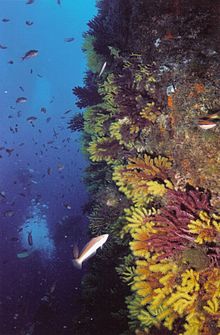Color changing gorgonian
| Color changing gorgonian | ||||||||||||
|---|---|---|---|---|---|---|---|---|---|---|---|---|

Color-changing gorgonian ( Paramuricea clavata ) |
||||||||||||
| Systematics | ||||||||||||
|
||||||||||||
| Scientific name | ||||||||||||
| Paramuricea clavata | ||||||||||||
| Risso , 1826 |
The color-changing gorgonian ( Paramuricea clavata ) is a horn coral species endemic to the Mediterranean .
distribution and habitat
The Color-changing sea fan is in the western basin of the Mediterranean and in the Adriatic endemic . Larger occurrences of the species are found on the Costa Brava , Côte Vermeille , Côte d'Azur , Corsica , Sardinia , the Strait of Messina and on the Ligurian coast, including the islands of Elba , Giglio , Giannutri , Montecristo , Capri and Ischia . Paracuricea clavata can be found on rocks and steep walls from a depth of approx. 10 to 100 m. The species often settles on wrecks, provided that the location of the wrecks brings sufficient currents and nutrients.
features
The color-changing gorgonian forms fan-shaped colonies that branch out densely and irregularly, especially in one plain, and can reach a height of about one meter. Like all gorgonians, the color-changing gorgonian has an elastic inner skeletal axis made of gorgonin . The gorgonin is enveloped by a soft bark in which the polyps are embedded. The individual polyps are close together and are about 8 mm high. They can retreat completely and have eight feathery tentacles and are always the same color as the bark tissue. The name Color Changing Gorgonian and the old scientific species name Chamaeleon refer to the different color variants of the species. There are red, yellow and red-yellow variants. The color differences are due to a different food supply. The color-changing gorgonian grows at a rate of about one to six mm per year. It takes at least 10 to 15 years for the colony to reach its maximum size. It can reach an age of more than 20 years.
Way of life
The color-changing gorgonian grows perpendicular to the prevailing flow direction on exposed rocks and steep walls at a depth of 10 to 100 meters. The species loves shade and avoids direct sunlight. Paramuricea clavata feeds on plankton , which is caught from the current with the help of the polypentacles covered with stinging cells . Numerous ride-on organisms use the gorgonian as a settlement area. Lime tube worms ( Filograna sp.), Bird clams ( Pteria hirundo ) and hydrozoans often settle on the color-changing gorgonian. As a specialty one can discover the gorgonian porcelain snail ( Slimnia spelta ) on Paramuricea clavata . This 15 mm large snail is a decided food specialist and feeds on the polyps and the living axial tissue of the gorgonian.
literature
- Matthias Bergbauer, Bernd Humberg: What lives in the Mediterranean? , Franckh-Kosmos Verlags-GmbH & Co.KG, Stuttgart 2009, ISBN 3-44011-736-7
- Claus Valentin: Fascinating underwater world of the Mediterranean , Paul Parey publishing house, 1987, ISBN 3-49012-018-3
Individual evidence
- ↑ a b c What lives in the Mediterranean? , Berbauer Humberg, Franckh-Kosmos Verlags-GmbH & Co.KG, Stuttgart 2009, p. 120
- ^ Fascinating underwater world of the Mediterranean , Claus Valentin, 1986, p. 116


